Visual Guide to US Mobile Radio Bands
Oct 19, 2017, 1:01 PM by Rich Brome
originally published May 16, 2016
updated Oct 21, 2017, 10:43 AM
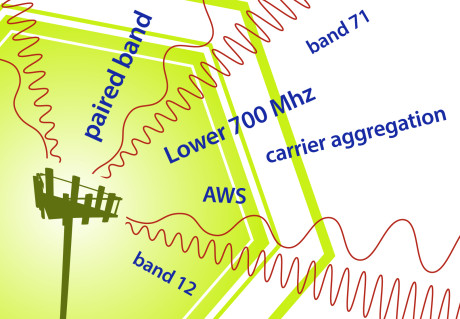
Updated to include the new band 71. Band 12? AWS? Lower 700 MHz? What does it all mean? We explain the arcane world of the radio frequency bands used for mobile phones in the US, in this one-of-a-kind, interactive, visual guide.
The radio frequency bands used by phones may seem like a dull topic, but it can actually be an important consideration when choosing a phone. For example, when the iPhone 6s came out, there was some excitement that it supported AT&T's bands 29 and 30. Newer T-Mobile phones support LTE band 66, while older phones do not. Band 71 is altogether new and only the newest phones support it. These things may seem nerdy, but they're all actually quite important. Why? That's what this article aims to explain.
Let's start with the basics. Radio spectrum refers to the whole range of radio frequencies. A higher frequency means the signal (radio wave) oscillates faster, like a higher-frequency sound wave. But while our ears can hear and discern a wide range of sound frequencies at once, radios are designed to "hear" just certain specific frequencies. Therefore, two radio devices operating in the same area won't interfere as long as they use different frequencies. That makes frequency a handy way to divide up the airwaves for different uses, like TV, radio, and phones.
Bands
The government divides our radio spectrum up into many discrete ranges of frequencies. Each of these ranges is called a "band", and each band is assigned a specific purpose. The FCC is the government agency in charge of this for the U.S.. This is what the U.S. radio spectrum allocation chart looks like:
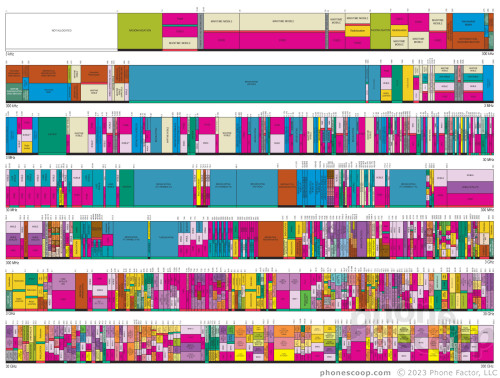
Don't bother trying to read the chart. (It's a bit outdated anyway.) The point is: Each little colored box in that chart is a band. There's a ton of them.
Some bands are used by the military, police and firefighters. Many different bands are allocated to boats and planes, and satellites take a fair chunk as well. RADAR uses radio waves, so there are bands for that, too.
And of course, some bands are dedicated to the mobile networks that connect your phone to the world.
Growth
Each call and each data connection takes up a tiny bit of spectrum, so as the population grows and more people use phones and other connected devices — and use them to do more things — mobile networks require more spectrum to handle the additional usage.
Upgrading to newer technologies also requires additional spectrum. Newer technologies make more efficient use of spectrum, but companies usually need to keep the old networks running side-by-side with the new ones for many years while they roll out the more advanced technology and transition to it, so customers with old phones aren't cut off. Typically, the new and old technology each need to run in their own separate chunk of spectrum, so a surplus of spectrum is required to make such upgrades.
More spectrum means more bands.
New Bands
One key thing to understand about radio spectrum is that it's all allocated for something; there is almost no "empty" spectrum sitting around waiting for a purpose. (You can see that the chart above doesn't have many empty spaces.) That makes spectrum a limited and extremely valuable resource.
So where do "new" bands come from? Well, it generally starts with the government carefully coordinating the relocation of whatever previously used those frequencies. For example, it may mean budgeting money for the military to replace all radio equipment using those frequencies with new equipment that will use different frequencies.
These kinds of relocations are usually difficult and expensive, which is why they don't happen often. (And sometimes they're just not possible. We can't just hop up to space and replace a satellite's radio with one that uses a different frequency.) That's why the FCC has very limited options when trying to carve out "new" spectrum to auction off to meet demand.
But there is one trend that's been very helpful in coming up with new bands for phones. Let's start by looking at a simpler version of the chart above, focusing on just the bands you're probably most familiar with:
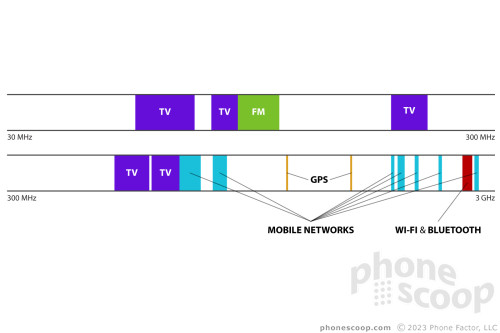
As you can see, the bands set aside for TV are relatively huge. That's partly because they were allocated back in the age of analog technology, which was horribly inefficient compared to modern digital signals. When TV upgraded to HD, it also upgraded to efficient digital technology, which requires less spectrum. This freed up spectrum for mobile (phone) networks. That's where phone bands 12 and 13 came from (also known as the 700 MHz band.)
Another reason so much spectrum was set aside for TV is that it was allocated in the days before cable, satellite, and streaming TV. Over-the-air was the only way to get TV, so we needed spectrum for 80 channels.
There isn't that kind of demand for over-the-air TV anymore, so now the FCC is further consolidating the remaining over-the-air TV stations into a smaller part of the spectrum. They're doing this via a "reverse auction" where they basically pay TV stations to move to different frequencies.
This will free up additional spectrum for mobile networks. This is called the 600 MHz band, and the FCC will auction it off in 2016.
Blocks
Companies offering mobile phone service in the U.S. need licenses from the FCC in order to use those bands. For larger bands, each individual license covers just part of the band. These parts are called "blocks". This is how two companies can operate in the same band; they actually own licenses for different parts (blocks) within that band, so they don't interfere with each other.
For example, here's how the PCS band (AKA band 2 / band 25) is divided up by blocks in Philadelphia:
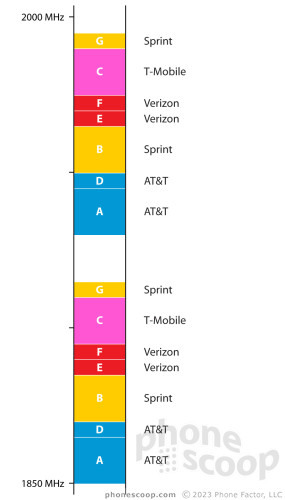
(It's different in other places; we'll get to that in a sec. And you're not seeing double, there are two of each block. We'll explain why in a bit.)
Some smaller bands are not divided into blocks. Such bands are usually used by only one company.
Licenses
Each FCC license covers one block (or small band) and one geographic area. Most bands are divided geographically, and those divisions vary by band (and even block.) For example, Verizon needed to buy only six licenses to own band 13 across the continental U.S., but many other blocks are structured such that you'd need to buy hundreds of licenses to cover the whole country.
Some smaller bands are not divided by region, but rather have just one national license.
A license gives a company exclusive use of that block/band in that area, so it's like owning part of the radio waves. Some blocks have been sub-divided ("partitioned") since they were first auctioned off, and are now owned by different companies.
Regardless of how they're divided geographically, these licenses are usually sold via auctions held by the FCC. Those auctions are rare, and once the licenses are sold, the winning bidders then have a lock on that spectrum. New companies entering the market can't just buy fresh new licenses; they usually need to wait for the next auction. The same is true for existing companies that find they need more spectrum to handle growing demand.
Companies can also buy and sell existing licenses privately among themselves, or lease them. Companies may also acquire existing licenses by buying or merging with another company.
However, the FCC must approve each license transfer. With auctions, private license sales, and company mergers, the FCC enforces rules that keep one company from owning too much spectrum. This ensures competition that keeps service quality high and prices low. In the case of mergers, the FCC may require the new company to sell some of its licenses, or the FCC may arrange their transfer to other entities.
Global
This article focuses on the U.S., but things get far more complex if we look globally. There is a global organization that tries to "harmonize" global spectrum use so that phones around the world can use the same bands, but full harmonization just isn't realistic. Just imagine the complexity of that U.S. spectrum chart at the top, multiplied by every country on the planet, (since each country ultimately manages its own spectrum,) and you'll start to understand how hard it can be to coordinate these things globally.
As a result, there are now 50+ distinct bands defined globally for phone use. Many bands are used in more than one country thanks to harmonization efforts. But each country has a slightly different mix of bands, for various historical reasons.
Some bands overlap, also for historical reasons. For example, band 1 (used in Europe and Asia) overlaps with band 4 (used in the Americas), so a country with band 1 networks cannot have any band 4 networks, or vice-versa. If they did, the overlap means they would interfere.
Other bands overlap because they have expanded. For example, in the U.S., band 25 includes all of band 2, plus the newer PCS "G" block that was added after band 2 was defined. This doesn't necessarily make the two bands incompatible. Most phones that support band 25 can use band 2 networks. But phones do need to support the larger band (25) to access networks using the extra (G) block.
Paired Bands
Most "bands" we talk about in this article are actually two bands with a gap in the middle; this is called a "paired" band. The pair consists of one half that is used for towers to transmit to phones, and the other half for phones to transmit to towers. This is called FDD (frequency division duplex). It's the most common way to keep transmissions in one direction from interfering with transmissions in the other direction.
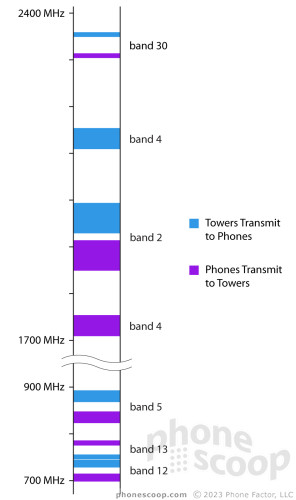
In other words — in the graphic above — phones "listen" on the blue bands, and "talk" on the purple bands. Vice-versa for towers.
However, some bands are not paired; they're just one big, contiguous band. These can be used for one-way transmission, or with a technology called TDD (time division duplex). TDD means that the phone and tower "take turns" transmitting. These "turns" are extremely short and fast (so fast that they're imperceptible to humans).
Frequencies
Frequency is measured in Hertz, which is abbreviated Hz. The whole range of radio spectrum is pretty huge: 10,000 - 300,000,000,000 Hz. The metric system is used to abbreviate that, so 300,000,000,000 Hz would typically be written 300 GHz.
Different frequencies have different natural properties. Lower frequencies travel farther and penetrate solids better (solids such as foliage and buildings, so this is important for indoor coverage), while higher frequencies can carry more information (faster data rates, etc.) The best balance of these properties for the purpose of cell phones is in the range of roughly 600 - 2,600 MHz. (2,600 MHz could also be written 2.6 GHz, since 1 GHz = 1,000 MHz.)
One important thing to note is that some bands (and some blocks within those bands) are larger than others. Larger bands and blocks can handle more users and/or more data. This is measured in band-width. For example, 700 - 710 MHz would be a band that's 10 MHz wide. For a paired band, there are different ways to refer to bandwidth. If it's 5 MHz of bandwidth in each direction, that might be referred to as 10 MHz, 5 + 5 MHz, or 2 x 5 MHz wide.
Technologies
In addition to different bands, there are different technologies that can be used in those bands. In the U.S, it's generally up to the companies (carriers) that own the licenses to decide which technology to use in which band, (within the limits of FCC rules designed to prevent interference.)
The current technology that dominates mobile networks is LTE, a 4G (4th-generation) technology. Older technologies still in use include WCDMA, CDMA, and GSM.
The combination of a specific technology in a specific band is called a "mode", and it's usually written as the technology followed by the band number or name, such as "LTE 12" or "CDMA 1900". When listing all of the modes a phone (or network) supports, it's usually abbreviated like this:
LTE 2 / 4 / 13
CDMA 850 / 1900
Most U.S. carriers operate networks that include multiple technologies and multiple bands. Similarly, most phones support multiple technologies and multiple bands. Traditionally, the phone and network work together to choose one technology — and one band — to use to communicate at any given moment. Newer/better technologies are used whenever possible. Complex rules govern which band is chosen.
Various technologies do allow the simultaneous use of more than one technology and/or band. SVLTE allows the use of CDMA (for voice) at the same time as LTE (for data).
Also, in LTE networks, bands can be virtually joined together to act as one, using technology known as Carrier Aggregation. This is part of an updated version of LTE called LTE Advanced, sometimes abbreviated LTE-A. With carrier aggregation, a phone can make use of multiple bands at the same time to communicate with the network. This opens up more spectrum to the connection, permitting faster data speeds.
The More the Merrier
It's important that your phone supports as many of the bands offered by your carrier's network as possible. That gives the phone more choices to find the best band to use, which varies as you move around, and as network conditions change. You simply won't get the best coverage and service if your phone only supports some of the bands your network offers.
Also, the more bands your phone can access for LTE, the more likely it is that your phone will be able to use carrier aggregation, boosting your data speeds.
Band Numbers and Names
The names and numbers for these bands have evolved over time. The first one set aside for phones in the U.S. was simply called the "cellular" band, because it was the only one used for cellular service at the time. Then as demand grew, the "PCS" band was created.
Names quickly became cumbersome and the industry switched to numbers that approximated the frequencies. The cellular band became the "800" band, because it spanned 824 - 894 MHz. Similarly, the PCS band became the "1900" band because it's 1850 - 1990 MHz.
However, that system also became cumbersome as new bands were created that were very close in frequency, or even overlapped. The U.S. had two different "800" bands, and both were different from an "800" band used in Japan, while Europe was considering a new (and different) "800" band of its own. So a new numbering system debuted with the advent of 3G networks in Europe.
Europe's new band dedicated to 3G was band 1, and existing bands were assigned numbers 2 and up. The new numbers had no correlation to when the bands were created, nor the relative radio frequency. The 800 band became band 5, and the 1900 band became band 2. These band numbers were typically written as roman numerals, so band 5 was more commonly known as band V, for example.
This system worked well until the advent of 4G, when growing demand for mobile data sent governments scrambling to open up new frequencies, and the number of bands skyrocketed to nearly 50 different bands. The numbering system from 3G was kept, but roman numerals were dropped in favor of standard decimal numbers.
The new scheme designated bands 1-32 for paired bands using FDD technology, and higher band numbers for unpaired bands using TDD technology (such as Sprint's band 41). (LTE is available in both FDD and TDD versions.)
However, inevitably, there was demand for additional FDD bands, so now new FDD bands are numbered 65 and higher. That includes bands 66 and 71, which are now used by T-Mobile.


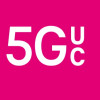 T-Mobile Rolling Out New Icon to Differentiate Fast 5G from Regular 5G
T-Mobile Rolling Out New Icon to Differentiate Fast 5G from Regular 5G
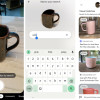 Google Lens Now Lets You Refine a Visual Search with Text
Google Lens Now Lets You Refine a Visual Search with Text

